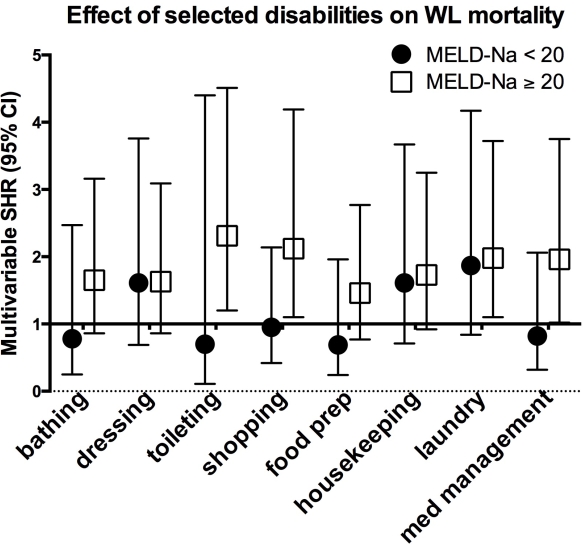Physical Disability on the Liver Transplant Waitlist: Results from the Functional Assessment in Liver Transplantation (FrAILT) Study.
University of California, San Francisco, San Francisco, CA.
Meeting: 2016 American Transplant Congress
Abstract number: B266
Keywords: Liver cirrhosis, Liver transplantation, Mortality, Risk factors
Session Information
Session Name: Poster Session B: Liver: MELD, Allocation and Donor Issues (DCD/ECD)
Session Type: Poster Session
Date: Sunday, June 12, 2016
Session Time: 6:00pm-7:00pm
 Presentation Time: 6:00pm-7:00pm
Presentation Time: 6:00pm-7:00pm
Location: Halls C&D
Background: Cirrhosis leads to sarcopenia and functional decline that can severely impact one's ability to function at home and in society. Self-reported disability scales to quantify disability – Activities of Daily Living (ADL) and Instrumental ADL (IADL) – are validated to predict mortality in older adults.
Methods: To evaluate disability in liver transplant (LT) candidates and quantify its impact on outcomes, consecutive outpatients ≥18y listed for LT with laboratory Model for End-stage Liver Disease (MELD) score ≥12 at a single high-volume U.S. LT center were assessed for ADLs and IADLs during clinic visits. MELD-Na was cut at the 75th %ile (< and ≥20). Multivariable competing risk models adjusted for hepatic encephalopathy and ascites[M1] with LT as competing risk explored the effect of interaction between time-varying MELD-Na and disabilities on waitlist mortality (death or delisting for illness).
Results: Of 458 patients: 36% were women, median (interquartile range [IQR]) age was 60y(54-64), initial MELD-Na was 16 (13-20). At first visit, 31% had lost ≥1 ADL, 40% ≥1 IADL. The most prevalent ADLs lost were continence(22%), dressing(12%), and transferring(11%); the most prevalent IADLs lost were shopping(28%), food prep(23%) and med management(22%). At median 9mo of follow-up, 35% had received LT, 16% died or were delisted for illness. Among those with MELD-Na<20, no disabilities were associated with increased hazard of waitlist mortality. Among those with MELD-Na ≥20, difficulty with toileting (getting to the toilet, cleaning oneself, getting dressed) [SHR 2.3, 95% CI 1.2-4.5], shopping (SHR 2.2, 95%CI 1.1-4.2), laundry (SHR 2.0, 95%CI 1.1-3.7), and med management (SHR 2.0, 95% CI 1.0-3.8) were associated with increased waitlist mortality.
Conclusions: ADL/IADL deficits are common in LT candidates. Toileting, shopping, laundry, and med management are strongly predictive of waitlist mortality in those with MELD-Na≥20. Routine visits with LT candidates should use these simple metrics to identify those at increase risk of adverse waitlist outcome independent of liver disease severity.

CITATION INFORMATION: Samoylova M, Haftek M, Shiboski S, Covinsky K, Roberts J, Lai J. Physical Disability on the Liver Transplant Waitlist: Results from the Functional Assessment in Liver Transplantation (FrAILT) Study. Am J Transplant. 2016;16 (suppl 3).
To cite this abstract in AMA style:
Samoylova M, Haftek M, Shiboski S, Covinsky K, Roberts J, Lai J. Physical Disability on the Liver Transplant Waitlist: Results from the Functional Assessment in Liver Transplantation (FrAILT) Study. [abstract]. Am J Transplant. 2016; 16 (suppl 3). https://atcmeetingabstracts.com/abstract/physical-disability-on-the-liver-transplant-waitlist-results-from-the-functional-assessment-in-liver-transplantation-frailt-study/. Accessed December 19, 2025.« Back to 2016 American Transplant Congress
